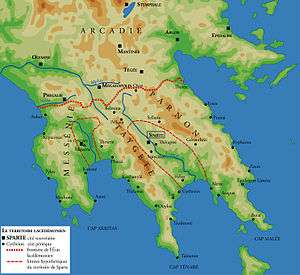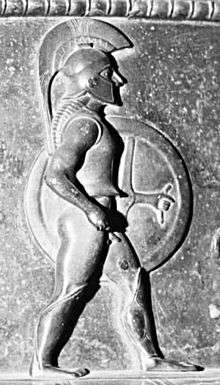Pausanias of Sparta
Pausanias (Greek: Παυσανίας) was the Agiad King of Sparta; the son of Pleistoanax. He ruled Sparta from 445 BC to 426 BC and again from 408 BC to 395 BC.

Early life
Pausanias took his first reign while still a minor, during a time of political unrest. Around 446 BC, Euboea and Megara rebelled against the Athenian empire and the Peloponnesian forces under the command of Pleistonax invaded Attica (Athens) going as far as Eleusis and Thria. His father Pleistoanax was temporarily deposed and exiled after being charged by the Spartans with taking a bribe, probably from the Athenian leader, Pericles, to withdraw from the plain of Eleusis in Attica. Pausanias took the throne in 445 BC and ruled until 426 BC, when his father was recalled and restored as Agiad King of Sparta. Pleistoanax held this role until his death in 409 BC. In c. 408 BC, Pausanias once again became the Agiad King of Sparta.[1]
Peloponnesian War
Following the Spartan victory over Athens in the Battle of Aegospotami in 405 BC, the Spartans were in a position to finally force Athens to capitulate. Pausanias laid siege to Athens' main city while the Spartan admiral Lysander's fleet blockaded the port of Piraeus. This action effectively closed the grain route to Athens through the Hellespont, thereby starving Athens. Realising the seriousness of the situation, the Athenian statesman, Theramenes, started negotiations with Lysander. These negotiations took three months, but in the end Lysander agreed to terms at Piraeus. With the capitulation of Athens the Peloponnesian War ended in 404 BC.
Lysander then put in place a puppet government in Athens with the establishment of the oligarchy of the Thirty Tyrants under Critias which included Theramenes as a leading member. However, in 403 BC Pausanias was able to undermine Lysander's dominance of Athens after Pausanias gained the command of the Peloponnesian League expedition against the Athenian democrats then based in Piraeus. Despite opposition from Lysander, Pausanias took the opportunity to promote a reconciliation between the democratic party in Piraeus and the oligarchs controlling Athens' main city, thus allowing the re-establishment of democratic government in Athens. Pausanias was able to restore democracy in Athens while bringing the Athenians, temporarily, into an alliance with Sparta.
Pausanias's actions led to a major conflict with the Spartan ephors. Pausanias was prosecuted, but then acquitted.
Corinthian War
Returning to Sparta in 395 BC, Lysander was instrumental in starting a war with Thebes and other Greek cities, which came to be known as the Corinthian War. The Spartans prepared to send out an army against this new alliance of Athens, Thebes, Corinth and Argos (with the backing of the Persians).
The Spartans arranged for two armies, one under Lysander and the other under Pausanias, to rendezvous at and attack the city of Haliartus, Boeotia. Lysander arrived at the city while Pausanias's forces were still several days away. Not willing to wait for Pausanias, Lysander advanced to Haliartus with his troops. In the ensuing Battle of Haliartus, Lysander was killed after bringing his forces too near the walls of the city. Pausanias's army arrived after Lysander's defeat but then left the battle scene primarily due to Athenian military opposition. King Pausanias negotiated a cease of fighting so the bodies of the dead were able to be collected for a proper burial. After, the Spartan army returned to Sparta.
Because of his poor leadership at Haliartus, Pausanias was condemned to death by the Spartans and replaced as king by his young son Agesipolis I.
However, Pausanias was able to escape execution and fled Sparta to live in exile in Tegea.
Exile
While living in Tegea, Pausanias wrote a pamphlet. No fragments of the pamphlet have survived and its contents or purposes are not clear. However, it seems that he wrote the pamphlet to criticize his opponents in Sparta accusing them of violating traditional Spartan laws and advocating the abolition of the ephors.
Pausanias is believed to have outlived his son, Agesipolis I, according to an inscription found on a monument set up by Pausanias to the memory of his son in Delphi.[2]
The year of Pausanias's death is sometime after 380 BC.[1] He was also the father of Cleombrotus I.
References
- Powell, Anton (2017). Companion to Sparta. Accessed December 14, 2019. ProQuest Ebook Central: Somerset: John Wiley & Sons, Incorporated. p. 100.CS1 maint: location (link)
- Parke, H.W. "The Disposing of Spartan Kings". The Classical Quarterly. 39, no. 3-4 (1945): 106–112.
- Plutarch, Lives. Life of Lysander. (University of Massachusetts/Wikisource)
- Xenophon, Hellenica. (Wikisource/Gutenberg Project)
- Pausanias. Description of Greece. Translated by Jones, W.H.S. and Omerod, H.A. Loeb Classical Library Volumes. Cambridge, MA, Harvard University Press; London, William Heinemann Ltd. 1918.
- "Pausanias" in the Oxford Dictionary of the Classical World
- "Pausanias" in the Oxford Who's Who in the Classical World
| Preceded by Pleistoanax |
Agiad King of Sparta 445–426 BC and 408–395 BC |
Succeeded by Agesipolis I |
